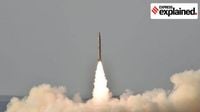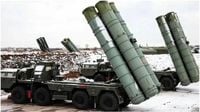In the quiet agricultural fields of Jethuwal village near Amritsar, India, residents stumbled upon a startling discovery that has sparked intrigue and raised questions about a potential high-stakes technological showdown. On Thursday morning, locals found scattered metal debris, described as partially charred and bearing signs of explosive damage, prompting a swift response from authorities.
According to the Indian defense news outlet idrw.org, the fragments are suspected to be remnants of a 48N6 missile, a key component of India’s advanced S-400 air defense system. Unconfirmed reports suggest the debris may be linked to an attempt to intercept a Chinese-designed rocket artillery system, possibly launched by Pakistan, following reports of explosions heard in Amritsar around 2 a.m. local time.
The find comes amid heightened tensions between India and Pakistan, but the real story lies not in the geopolitics but in the rare clash of cutting-edge Russian and Chinese military technology on Indian soil. The discovery of the debris has thrust the S-400, one of the world’s most sophisticated air defense systems, into the spotlight.
Developed by Russia’s Almaz-Antey corporation, the S-400 Triumf is designed to protect against a wide range of aerial threats, from stealth aircraft to ballistic missiles. India, which began receiving the system in 2021 under a $5.4 billion deal with Russia, has integrated it into its air defense network to counter regional threats, particularly along its volatile borders with Pakistan and China.
The 48N6 missile, the suspected remnant found in Jethuwal, is a cornerstone of the S-400’s arsenal. Measuring approximately 7.5 meters in length and weighing nearly 1.9 tons, the missile is equipped with a 180-kilogram high-explosive warhead and an active radar homing system, allowing it to engage targets at ranges up to 250 kilometers and altitudes as high as 27 kilometers. Traveling at speeds exceeding 2.5 kilometers per second, the 48N6 is engineered to intercept fast-moving, low-flying targets, including cruise missiles and rocket artillery, with pinpoint accuracy.
The S-400’s operational mechanics are a marvel of modern engineering. Its long-range surveillance radar can detect targets at distances up to 600 kilometers, feeding data to a command center that coordinates multiple launchers. Each launcher carries up to four missiles, which can engage up to 36 targets simultaneously, thanks to the system’s advanced fire-control algorithms.
In the context of Amritsar, the system’s ability to detect and neutralize low-flying, high-speed threats would have been critical if, as speculated, it was tasked with intercepting a rocket artillery barrage. The challenge of countering such threats lies in their speed and trajectory—rocket artillery often follows a low, unpredictable path, making them difficult to track and destroy before they reach their target.
The debris in Jethuwal, described by idrw.org as a “partially burned airframe,” suggests the 48N6 may have detonated close to its intended target, leaving behind fragments that survived the blast. The lack of reported damage or casualties in the village, as noted by Deccan Chronicle, indicates the incident occurred at altitude, with the debris falling harmlessly to the ground.
However, the timing of the find aligns with reports of explosions in Amritsar, fueling speculation that India’s S-400 may have been activated to thwart an attack. The Indian Ministry of Defence has remained silent on the matter, leaving room for conjecture about the nature of the threat and the system’s performance.
Unconfirmed reports, as cited by idrw.org, point to a possible Chinese-designed rocket artillery system as the target of the S-400’s interception attempt. Pakistan, which maintains a robust arsenal of Chinese-supplied weapons, is known to operate systems like the A-100 multiple-launch rocket system (MLRS). The A-100, developed by China’s Aerospace Long-March International, is a 300mm rocket system capable of delivering precision strikes at ranges up to 120 kilometers.
Each rocket carries a 240-kilogram warhead, which can be equipped with high-explosive, fragmentation, or cluster munitions, making it a formidable weapon for rapid, saturation-style attacks. The system’s mobility, mounted on a wheeled chassis, allows it to fire a salvo of up to 10 rockets in seconds before relocating to avoid counterstrikes. Its low-altitude flight profile, often below 15 kilometers, poses a significant challenge to air defense systems, requiring rapid detection and response.
Another potential candidate is the PHL-03, a more advanced Chinese MLRS also in Pakistan’s inventory. With a range of up to 150 kilometers and enhanced guidance systems, the PHL-03 can deliver rockets with greater accuracy, rivaling Western systems like the U.S. M270 MLRS.
Both the A-100 and PHL-03 are designed for surprise attacks, launching volleys that overwhelm defenses through sheer volume. If such a system was indeed used against Amritsar, the S-400’s task would have been to detect the incoming rockets, prioritize targets, and deploy the 48N6 to intercept them before impact. The debris in Jethuwal suggests at least one missile was engaged, but whether it successfully neutralized the threat remains unclear.
The broader context of the incident underscores the rarity of the technological matchup. Russian and Chinese military systems are seldom pitted against each other in real-world combat, as both nations maintain a strategic partnership. India’s acquisition of the S-400, despite U.S. objections and threats of sanctions under the Countering America’s Adversaries Through Sanctions Act (CAATSA), reflects its determination to bolster its air defenses against regional rivals.
Pakistan, meanwhile, has deepened its reliance on Chinese technology, including missiles like the Fatah-II, a 400-kilometer-range ballistic missile designed to challenge the S-400, according to The Diplomat. The Fatah-II’s high accuracy, with a circular error probable (CEP) of less than 10 meters, makes it a credible threat to mobile targets like air defense systems.
While there is no evidence linking the Fatah-II to the Amritsar incident, the possibility of Chinese-designed rocket artillery being used highlights the evolving arms race in South Asia. The historical significance of the S-400 adds another layer to the story. First deployed by Russia in 2007, the system has seen limited combat use, primarily in Syria, where it has been credited with deterring NATO aircraft but has not faced rocket artillery in large-scale engagements.
India’s deployment of the S-400, with five regiments planned for delivery by 2026, marks a major upgrade to its air defense capabilities, previously reliant on older Russian systems like the S-125 Pechora and indigenous platforms like the Akash. The 48N6 missile, in particular, has a proven track record in tests, with a reported success rate of over 90% against simulated targets.
Its ability to engage low-flying, high-speed threats like rocket artillery is well-documented, but real-world combat data is scarce, making the Jethuwal incident a potential milestone in the system’s operational history. The debris itself is a puzzle that may hold clues to the incident’s outcome.
The “explosive burn marks” noted by idrw.org suggest the 48N6’s warhead detonated, either upon impact with a target or prematurely due to a malfunction. If the missile successfully intercepted a rocket, the resulting explosion would have scattered fragments of both projectiles, complicating efforts to identify the debris. Alternatively, the wreckage could be solely from the 48N6, indicating a missed intercept or a deliberate self-destruct to prevent sensitive technology from falling into hostile hands.
Forensic analysis, as reported by The Tribune, will likely focus on the debris’s metallurgy, burn patterns, and any residual electronics to confirm its origin. Until results are released, the wreckage remains a tantalizing hint of a high-tech duel in the skies.
The incident occurs against a backdrop of escalating tensions between India and Pakistan, fueled by India’s missile strikes on May 7, dubbed Operation Sindoor, in retaliation for a terror attack in Pahalgam, Kashmir, according to Firstpost. Pakistan’s military, which conducted missile tests earlier in the week, including the Fatah-II and Abdali systems, has vowed to respond to India’s actions, as reported by The Hindu.
The exchange of artillery and missile fire, which killed at least 26 people on the Pakistani side and eight on the Indian side, per Al Jazeera, has raised fears of a broader conflict between the nuclear-armed neighbors. Yet, the Jethuwal debris shifts the focus from the human toll to the technological stakes, offering a glimpse into a rarely seen contest between two of the world’s leading arms exporters.
For the United States, the incident raises questions about the proliferation of advanced weaponry in South Asia. The S-400’s presence in India, coupled with Pakistan’s growing arsenal of Chinese systems, complicates the regional balance of power. The U.S. Patriot PAC-3 system, a direct competitor to the S-400, shares similar capabilities but has not been adopted by India, which opted for the Russian platform due to cost and strategic ties.
The Jethuwal incident, if confirmed as an S-400 engagement, could provide valuable data on the system’s effectiveness, potentially influencing future arms sales in the region. The technological duel also highlights the global arms market’s complexities. Russia, despite its ongoing conflict in Ukraine, remains a leading supplier of air defense systems, with the S-400 exported to countries like China, Turkey, and India.
China, meanwhile, has emerged as a major player in rocket artillery, with systems like the A-100 and PHL-03 finding buyers in Pakistan and beyond. The irony of Russian and Chinese technologies clashing in a third country, mediated by India and Pakistan, underscores the unpredictable nature of modern warfare, where alliances and rivalries are as much about engineering as ideology.
As investigators sift through the wreckage in Jethuwal, the world awaits answers about what transpired in the skies above Amritsar. Was this the S-400’s first real test against a Chinese-designed threat, or a fluke that left debris scattered in a quiet village? The silence from Indian and Pakistani authorities only deepens the mystery, but the fragments on the ground tell a story of precision, power, and the relentless march of military technology.
For now, the incident serves as a reminder that even in the most remote corners of the world, the tools of war are evolving, and their clashes are reshaping the battlefield of the future. What remains to be seen is whether this rare encounter will mark a turning point in the arms race or simply fade into the fog of conflict, leaving more questions than answers.





